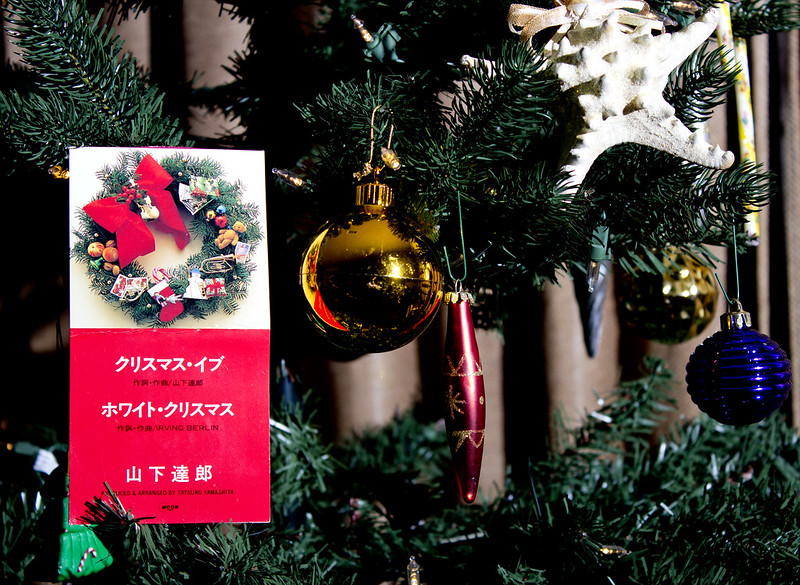
Featuring unreleased tracks studio recordings and also a live concert of Kawashima Eigo and his band that was released to celebrate the 10th year anniversary of Kawashima’s death. For fans of Kawashima Eigo, this is an album that features unreleased, rare tracks and also a chance to hear Kawashima experiment with different singing styles for many songs. It’s an album that I definitely recommend!
ARTIST: Kawashima Eigo
CD SINGLE: Mihappyo Rokuonshu
LABEL: Sony Music Talent
CATALOG #: MHCL-1895~6
DURATION: 143 Minutes
RELEASE DATE: May 4, 2011
TRACK LISTINGS:
Disc: 1
1. 出発
2. タンバリンをたたいておくれ
3. 11月の午後(こたつ) (未発表楽曲)
4. 今日の空は (未発表楽曲)
5. Hey Hey Hey (未発表楽曲)
6. 恋人たち (未発表楽曲)
7. 扉をあけて (未発表楽曲)
8. 雨の降る街 (未発表楽曲)
9. 秘密 (未発表楽曲)
10. 風のわすれもの (未発表楽曲)
11. こころやさしき人 (「いつまでも」原曲)
12. 風は東へ
13. 山の上から (未発表楽曲)
14. 展望台から
15. 100年たったら
16. 酒と泪と男と女
17. 何人もの人達と
18. かけがえのない人
19. 雨の日のひとりごと (未発表楽曲)
20. いくつかの場面
Disc: 2
1. 誕生日を前にして
2. あまぐも
3. MC
4. カラス
5. 青春旅情
6. ポプラ
7. あきらめ顔は早すぎる
8. 箱入り息子
9. モサクどんの運動会
10. エンジンを止めてくれ
11. 夕陽を食べたふたり
12. ベナレスの車引き
13. 旅のわすれもの
14. 仁醒(一枚の絵)
15. 二十七才
16. タンバリンをたたいておくれ
17. 回送電車
18. 出発
Today I am listening to Kawashima Eigo’s “Mihappyo Rokuonshu” (Unreleased Recordings) album.
Eigo passed away in 2001 of liver disease but to celebrate his 10th year anniversary of his death, his label released a double CD of unreleased master tapes that were found in his warehouse.
For those not familiar with Kawashima Eigo, he was a Japanese singer-songwriter and actor. His music was appreciated by many men as his songs were about strength, loneliness, kindness and fatherhood.
He was a singer that not only performed in big venues, but he would go to mountainous regions and remote areas to perform.
He started singing folk songs in high school back in 1969 and made his debut on Kyoto Records with the band Homo Sapiens and was influenced by singer/songwriter/music producer Yoshida Takuro (known as the “Father of J-Pop”).
By 1975, he would make his major solo debut and would be known for his debut song “Sake to Namida to Otoko to Otona”, a song which Kawashima wrote when he was 19 and observing his uncle’s life. The song would be used for a sake CM and become a national hit and Kawashima’s name would be known throughout Japan.
Known for his powerful, raspy singing voice, there are many albums by Kawashima Eigo and nearly two dozen singles that were released. And when everyone who was a fan of Kawashima’s music thought they have heard it all, now we have the release of “Mihappyo Rokuonshu” which were unreleased recordings that were discovered at a master tape warehouse and were never released to the public commercially until now.
Disc 1 features songs recorded from a recording studio in Kyoto at the JUJIYA Corporation, while disc 2 features songs recorded live in January 1981 at Sankei Hall in Osaka. So, these are rare recordings.
You get an unreleased recording of “Sake to Namida to Otoko to Otona”, but also popular songs such as “Hyaku-nen Dattara” and also songs in which his fellow bandmembers and backup singers vocals are also heard closely.
So, songs such as “Hey Hey Hey”, “Kaze wa Azuma e” (The wind to the east) and “Kakegae no nai hito” (irreplaceable person), you can hear the background singers with clarity.
But you also get vocal variation with Kawashima on this album.
I like the wild nature of the unreleased recording version of “Shuppatsu” (Departure) and to hear Kawashima singing in tandem with the backup singer and it’s a different style because Kawashima performs in a way almost like a punk song, screaming the track while you can hear the back singer closely. I actually enjoyed listening to this version of the song!
And then you have Kawashima singing with a falsetto voice with “Kaze no wasuremono” (forgettable wind) and the playful vocals and falsetto with “11-nen no Gogo (Kotatsu)” [November afternoon (kotatsu)].
For me, this was all interesting to hear Kawashima doing experimentation vocally.
With the second disc, it’s a live concert, so you get a lot of tracks (not included in the first track) and so you can hear the energized audience really getting into the performance of “Nijunanasai” (27-years-old) and “Tambourine wo Tatetaiteokure” and so much more!
Considering that the master tapes were kept sealed in a warehouse for over 30 years is magnificent for Kawashima fans today who get to listen to these tracks. The recording sounds great and it’s really cool to hear variations of his popular songs.
But for the most part, knowing that Kawashima Eigo continues to live on through his music and many people from different generations are enjoying it to this day. That’s pretty awesome!
“Mihappyo Rokuonshu” is highly recommended for Kawashima Eigo fans!







